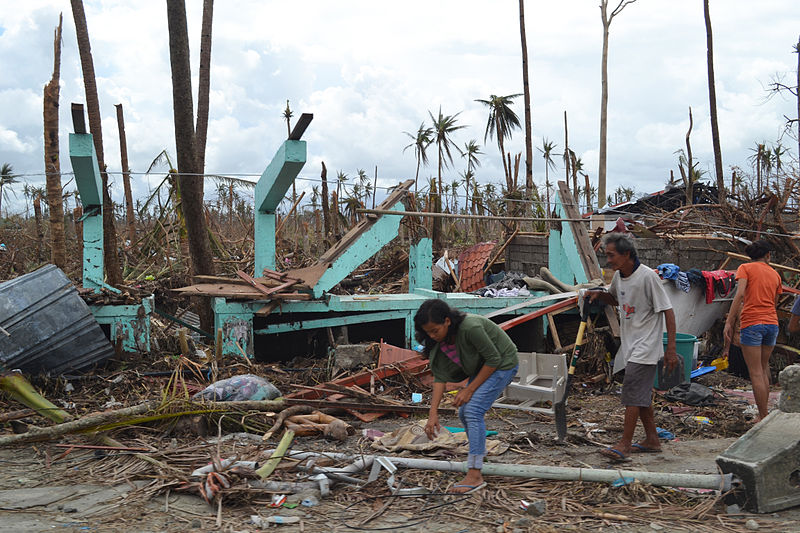
Home destroyed by Super Typhoon Haiyan/Yolanda, Tacloban City, Philippines
Philippine historian Ambeth R. Ocampo had a very interesting story in his column in the Philippine Daily Inquirer yesterday, 20 November. Tacloban was destroyed twice before by violent storms, in 1897 and in 1912.
Mr Ocampo quotes from an Australian newspaper, Barrier Mariner, 12 January 1898 [emphasis added]:
TYPHOON AND TIDAL WAVE IN THE PHILIPPINES. 7,000 Lives Lost. Mail advices, brought by the steamer Gaelic from Chinese and other ports in the Far East, contain details of the fearful destruction wrought in the Philippine Islands by the typhoon and tidal wave during October [1897]. It is estimated that 400 Europeans and 6,000 natives lost their lives, many being drowned by the rush of water, while others were killed by the violence of the wind. Several towns have been swept or blown away. The hurricane first struck the Bay of Santa Paula, and devastated the district lying to the south of it. No communication with the neighborhood was possible for two days. The hurricane reached Leyte on Oct. 12, striking Tacloban, the capital, with terrific force, and reduced it to ruins in less than half an hour. The bodies of 126 Europeans have been recovered from the fallen buildings. Four hundred natives were buried in the ruins.

Tacloban City, 14 November 2013
The Washington Herald of 20 November 1912 reports:
15,000 DIE IN PHILIPPINE STORM. That 15,000 persons were probably killed and wounded in a typhoon that swept the Philippine Islands last Tuesday was reported yesterday in cable dispatches to the Bureau of Insular Affairs.
The typhoon swept the Visayas and is said to have practically destroyed Tacloban, the capital of Leyte, and to have wrought enormous damage and loss of life at Capiz, the capital of the province of Capiz. Tacloban has a population of 12,000. Capiz has a population of over 20,000. Capiz is the terminal of the railroad from Iloilo. It is a most important sugar port.
The first news of the catastrophe came in a dispatch of the governor general of the Philippines. No figures of the dead or injured were given, but it was stated that probably half the population of the two cities had been lost. The governor general sent his dispatch on Thursday. He informed the department that he was rushing a shipload of food, clothing and all available medical supplies to Tacloban. All telegraphic communication has been destroyed, and it is impossible to get other than vague reports of the extent of the disaster. That Tacloban has suffered an enormous loss of life is believed to be certain. Following the receipt of the dispatch announcing the heavy casualties in the Visayas, the Red Cross prepared to rush a relief fund to the governor general. The Washington office has cabled the insular government asking how great is their need.
The town of Capiz referred to is now Roxas City. It now has a population of more than 156,000 while before Haiyan/Yolanda Tacloban City had a population of around 220,000. During the 1912 typhoon they had around 20,000 and 12,000 respectively. This suggests that relative to the population the typhoon 101 years ago was more devastating than Haiyan/Yolanda was. But the reports also imply that twice before Tacloban and other towns rose from post-typhoon ruin.
One of the ironies of Haiyan/Yolanda is that just as in 1912 All telegraphic communication has been destroyed and yet the world's media were able to show us live what was happening in Tacloban City and elsewhere this time.
Mr Ocampo ends his column with this statement: All of the above suggest we do not learn from history.
His statement also suggests to me that while we have to try to analyze climatic events and calamities to see if climate change and global warming are a major factor in storms such as Haiyan/Yolanda and to ask if we humans are responsible for this, we also have to ask other questions.

Haiyan/Yolanda approaching the Philippines, 7 November 2013.
Photos from Wikipedia page on Typhoon Haiyan.
